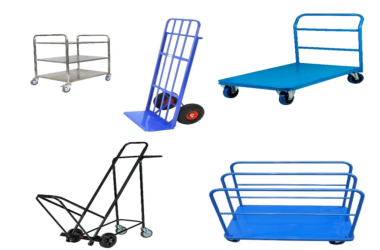Inventory planning is a constant challenge for any organization that must manage product inventory, such as those that handle consumer products, e-commerce, food, etc.
For any organization that relies on inventory, maintaining & calculating safety stock is a crucial component of inventory planning. To keep their operations operating smoothly and satisfy their consumers, all businesses require a constant supply of goods.
A high-selling item that repeatedly sells out will irritate customers, who may then shop elsewhere, and thus, businesses always try to hold as much inventory as possible.
However, this also creates a problem, and managers know that carrying excessive amounts of extra inventory results in high costs of maintaining that inventory and locking up the working capital. Thus one must find the right balance between meeting consumer demand and having low carrying costs. This is where the concept of safety stock comes into play.
What Is a Safety Stock?
Safety stock is the extra or buffers stock kept in the warehouse to prevent running out of an inventory item. It is a process for effective inventory planning. It is beneficial to prepare for changes in demand and take precautions against delays in getting new supplies.
Why is Safety Stock Essential?
Safety stock is necessary as it ensures that the inventory does not run out of stock, even if there is any supplier delay or a heightened demand. You would have a considerable quantity at hand to meet the demand.
- Safety stock safeguards against fluctuations in demand and helps to meet unexpected demand surges.
- Safety stock also acts as a buffer stock to save you against any delays in delivery by suppliers. There can be several reasons why stocks might be delayed, such as machinery breakdown, weather, etc.
- There can be disruptions in the supply chain due to the unavailability of raw materials, issues with transportation, natural disasters, etc. This increases the lead time for receiving the products, and there might be risks of stockouts. But with safety stocks through proper inventory planning, this can be avoided.
- Safety stocks ensure that there is no loss of sales and that products are always stocked in the inventory. Out-of-stocks circumstances would lead to customer dissatisfaction and would hamper brand loyalty.
- Fluctuations in market price results in an increase in the cost of the products. With safety stocks, you can overcome challenging and unprecedented situations.
- With a shortage of products, you might need to purchase products from new suppliers, leading to increased costs. With safety stocks, this can be avoided.
How to Calculate Safety Stock?
Businesses need to know how much safety stock they should keep. Too many safety stocks mean excess carrying costs, and too few stocks lead to lost sales. With a proper formula, you can calculate the optimal safety stock for your company with effective inventory planning. There are several formulas for calculating safety stock, such as:
1. Fixed Safety Stock
Production planners prefer this method as no specific formula is used, and the quantity remains constant unless the production manager changes. The fixed number can be low if the lead time is short and the sales rate is low.
2. Time-Based Calculation
Based on the forecast of a product, safety stock is calculated for a specific period. The predicted and actual demand are combined, but it is challenging to anticipate uncertainties. Thus there remains the risk of stocking excess items if the sales are slower than expected.
3. General Formula
This is the most common and simplest form of stock calculation, and it calculates the average safety stock for avoiding stockouts. However, seasonal demand fluctuations cannot be taken into consideration. Safety stock can be calculated by multiplying the maximum number of a product sold by the maximum lead time and then subtracting the average daily usage of that product.
4. Demand Variability
Demand variability is calculated as the average squared difference between actuals and forecasts daily.
5. Service Level Factor
Inventory planning systems will use various service level multipliers depending on how the SKU value is categorised. SKU classification is done on an ABC scale. A 95% service level for high-value SKUs is used, which means that it may account for up to 95% of historical discrepancies between actuals and projections.
6. Plan Coverage Days
This plan covers the duration and number of covered days and supplier lead times.
7. Supplier Fill Rate
The supplier fill level is the proportion of orders a supplier generally fills. Fill rate alters safety buffers by using GRN and previous purchase data at the SKU-vendor level. The 95th percentile of supplier lead time can be used to account for supplier lead time variability while generating order proposals in inventory planning systems.
Comprehend all these methods, identify which would suit your business best, and choose wisely.
Reasons for Keeping Safety Stock
The main arguments in favor of enterprises of all sizes maintaining safety stock inventories are listed below.
- You can lose sales and clients due to unanticipated supply chain disruptions and changes. You’ll be able to continue filling customer orders thanks to safety stock. Long and international supply chains result in more disruptions than usual.
- Safety stock will keep you afloat and help you sustain your service levels till your stock is replaced. It will help you make up for inaccurate forecasts and increased demand.
- Guarantees continuous manufacturing or shipment and a seamless supply chain.
- Increase client satisfaction by maintaining sufficient safety stockpiles to meet demand. Customers will be satisfied and continue to buy from you if you give them the things they want when they want. Additionally, they will spread the word about your goods and serve as brand ambassadors.
About the Company
Fountain9 assists retail companies in calculating safety stock effectively with their inventory planning software, Kronoscope. Kronoscope with its dynamic demand sensing and inventory planning capability, allows companies to maintain flexibility in safety levels to manage cash flows and working capital. Dynamic safety stock levels help optimize working capital by creating a dynamic buffer for only those products with high demand variability or unpredictable lead times. High dynamic safety levels should be maintained for high-selling products with high demand variability. This allows companies to optimize working capital by spending only on high-risk products, giving businesses more control over their supply chain and ensuring the inventory is optimally stocked.






